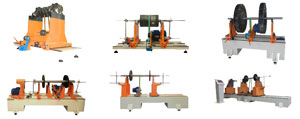The method of balancing a composite rotors
Work on the problems of balancing can be represented as follows: development of a method (based on research)- development of technology – execution. Earlier these problems did many different organizations: research and branch institutes, design bureaus, production facilities, etc. Now there is a trend to integrate manufacturers and developers into a single structure. Accordingly and problems balancing (and many others) need to be addressed as part of this structure.
In this regard, I want to share views about the challenges facing the area experienced balancing, methods for their solutions, as well as some suggestions on the organization of work in mass production.
Consider, first, in General terms, the development of technical process of balancing, lowering the design of tooling and some features of balancing machines, which are the subject of a separate report, simultaneously making suggestions for changes and additions to the operation of the machine “DIAMEH”. In General, for the development of the technology for the experimental production and for further work on serial must be used the same machines and tooling.
Fully developed and ready for transfer to mass production, the technology must ensure the balancing of any rotor maximum of three launches, and consistent accuracy.
The solution to this problem can be divided into two parts: the first is directly the process of balancing (selection of the speed; the machine set up and testing, determination of accuracy, etc.), the second is the identification and elimination of technological and hidden imbalances.
1.1. When choosing the rotor speed in low-frequency balancing must proceed from the features of that specific rotor and the technical capabilities of the machine. To do this, on my deep belief, should have in the measurement system of the machine the function “oscilloscope” for recording and analyzing the resulting signal with the primary transducers and the receipt of amplitude-phase-frequency characteristics (afch), and full, as if vibrodiagnostic research. The speed of the balanced rotor has to be in the area with the least interference using the principle of minimal sufficiency. Practice has shown the vital importance of the oscilloscope mode, the opportunity appeared during balancing to assess the condition of machine, tooling, bearings, etc.
1.2. A feature of the rotors of aircraft engines is a great variety of configurations: cantilever, disc, rotor the ratio of the distance between the supports to the distance between the planes of correction of the order of ten (for example, LPT), etc. have recently appeared multi-plane balancing, balancing on the main vector and main moment. Therefore, classic customization options in the plane of correction is not always effective enough. Configuration required in the technological plane, a special algorithm for cantilevered rotors, balancing on the main vector and main moment and differentiated several planes of correction, etc. Most rotors balacynwyd through a variety of balancing weights installed in strictly certain places. You need to create a program for the placement of cargo (for this purpose you can use the placement of the blades), for each rotor. Thus, setting the size of the rotor must represent not only the installation data and the calculated influence coefficients, and a software package for the solution of all problems on the balancing of this rotor.
1.3. The setting you have selected should be carefully checked experimentally. Ambulancewoman on the rotor to make technological goods and to compare the obtained result with the expected. With carefully checking the rotor is a complex configuration (balancing item) the possibility of hidden imbalances. Verification of residual unbalance conduct, guided by the requirements of GOST-22061-76.
2.1. An important component in achieving the necessary precision balancing are the technological imbalances. Technological imbalances can make any components and parts that are removed after balancing or which might change the position of the axis of rotation of the rotor or the main Central axis of inertia. All this must be considered in the development of technical process balancing. Consider some of them.
2.2. In practice balancing are often used in different technological mandrel, which inevitably create an imbalance, often significantly higher than the standard. Just balance them is not always enough, there are error based. The mandrel should be considered as a module. To address the technological imbalance of the mandrel it is necessary to balance the rotor and then expand it relative to the mandrel to 1800 . The resulting imbalance will be equal to twice the imbalance introduced by the mandrel. The result of this work, a rotor mounted on the mandrel in any position, should not change the imbalance.
2.3. Significant error can make working blades and some rotors. These errors arise either from pitching of the blades in the slots of the disks, either from their gear banding on the shelves. The problem is that the position of the blades when balancing on the machine, will be different from their situation when working on the product. To estimate the error from offset even one blade, say 10 ,as follows: to represent the static moment of the blade as a vector And / 00 and to combine it with the vector A / 1790 , where A is the static moment of the blade. To solve this problem in several ways:
2.3.1. To accelerate the rotor of the machine up to speed, sufficient to ensure that the blades under the action of centrifugal force, has taken its true position. It might work with blades without shroud. For blades with shroud platforms, you’ll likely need too much speed.
2.3.2. Use a torque scale and the program of arrangement of blades by static moment. A set of blades, in this case, should be considered as a module. Technique replace a set of blades without further balancing is a topic for another conversation, so let us take the fact that it worked. Then it will be possible to balance the rotor without blades, and then install it previously decomposed to the lowest possible residual imbalance vector, a set of blades (layout nil). Or, in cases where great accuracy of manufacture of the grooves of the disk, to use when balancing a specially prepared set of blades, simulators.
The functions of the machine, in this case, it is advisable to add the function of “the alignment of the blades” and connect the torque scales. Thus, given the above proposals, receive automated workplace “re-balancing”. You can also connect your printer, print the technical passport of the established sample. To enter into the computer the texts and sketches of the technologies, reference material, training programs and much more.
When developing methods of balancing, the key issue is the flexibility of the rotor. That is, quite simply, flexes the rotor at a rotation speed or not, and if it flexes, how it is. The answer to this question cannot be obtained without testing on the vacuum stand. Otherwise you have to act almost at random: based on very rough calculations, experience with other products (also very abstract) or just to balance the rotor as flexible, that is called just in case.
According to tests on the vacuum stand will make a decision about the choice of a particular technique of balancing for each specific rotor. It can be multi-plane balancing in one form or another, poelementno, maybe some high-speed balancing of rotors forming rotor dynamic characteristics (in this case it is necessary to equip the instrument for determination of natural frequencies), or make changes in the design. And, in some cases, if it is determined that the rotor is rigid, it is possible to balance it as hard which will reduce the complexity of balancing.Now I would like to say a few words about balancing in mass production. For example, the production was fully developed and tested, as described above technology. There is the question of its precise performance and control. Currently, the control is carried out when machines and equipment are periodically inspected, and each balancing contractor shall submit to the Comptroller, or by working on self-control. In those. the passport is closed, the balancing of multiple, often formal records. Meanwhile, everyone who worked long enough balanced, can recall a number of different cases of problems with balancing due to human error (most often) and various technical failures. The production now has a relatively small volume but large range of products. In these circumstances, often, justifiably, on one machine some rotors are balanced and the machine has to readjust. This increases the possibility of error, and the human factor, unfortunately, does not always work for the better.
Given all the above, I suggest to merge all measuring systems balancing machines in the enterprise into a single management system balancing process. If, as suggested earlier, they will have oscilloscope functions, the AFR will be possible to monitor the condition of machine, tooling, sensors, bearings, maybe a proper Assembly of the rotor, precision balancing, etc. almost in real time. To obtain the fault is not at the next test, and as soon as it appears. Monitoring can be done anywhere on the host computer, in which there will be a program all settings and record the frequency response of all the machines and rotors. Information about the beginning balance on any of the machines goes to the remote automatically. By comparison, perhaps even automated, frequency response and other parameters can be judged on the health system.
For example, the received data of the first start-up: frequency and comparing the installation data with the available computer memory, we can conclude that the machine is installed on the rotor, which is stated and that the system is working properly. The last start data allow us to conclude that the rotor is balanced within tolerance. Comparing the calculated data with the first start and really set the goods at the end of the balance, we can conclude that the setting is not “lost”. A comparison of the beginning and end of balancing is, in fact, a full check of the entire system and most importantly, it will be carried out at each balance.
The results of balancing in the form of records of these parameters to save in the computer’s memory, to create, so to speak, of the electronic passport of the rotor. This passport will be much more objective traditional. These e-passports will be helpful for statistics and analysis.
For example: the product is removed from the test due to high vibrations, analysis data electronic passport (a kind of “black box”) you can say that, at least from the point of view of performance balancing, no complaints, and the reasons should be sought elsewhere.
The experience of such a unified system and workstation at one site (8 machines, and different systems, generations, and years of release) is already available and much of the above has been successfully used.


